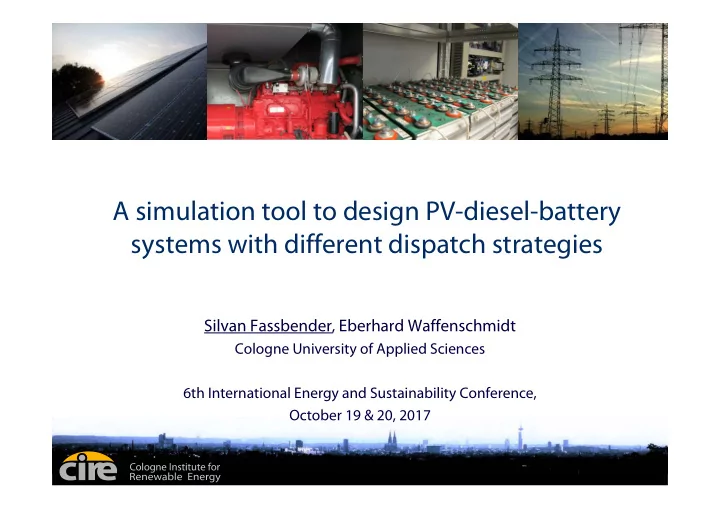

A simulation tool to design PV-diesel-battery systems with different dispatch strategies Silvan Fassbender, Eberhard Waffenschmidt Cologne University of Applied Sciences 6th International Energy and Sustainability Conference, October 19 & 20, 2017
Agenda Motivation Our hybrid energy tool Models Dispatch strategies Designing tool Simulation example Conclusion and perspective 2
Motivation Electricity in remote areas is often supplied by diesel generators They are often expensive (fuel costs) and emit CO 2 Renewable energy sources can improve profitability and reduce CO 2 -emissions But: part-load ranges below 50% and sudden load steps on diesel generators can reduce lifetime and higher emissions [1] 3
Motivation Common hybrid energy simulation tools: [3] [2] Technical detailed simulation Feasibility studies [4] Multifunctional tools [5] − Easy to use [6] − dispatch, design and economic functions − Optimization by genetic algorithm [7] 4
Motivation Hybrid Energy System Micro Grid Purpose for our tool PV Simulation of PV-diesel-battery systems Load Battery Easy-to-use Realistic simulation models Genset Smart dispatch strategies Model simulation in MATLAB Simulink and system design simulation in MATLAB GUI [8] 5
Our hybrid energy tool – models PV: Double-diode-model [9] Considers physical behavior, i.e. the I-V-Values of solar cells Combined with a MPP-Tracker Battery: Shepherd-model [10] Battery charging depending on cell voltage and state of charge (SOC) Experimental measured discharge curves can be applied − Currently only lead-acid battery can be applied 6
Our hybrid energy tool – models Diesel generator: advanced model Part-load dependent fuel cunsumption based on break specific fuel consumption (BSFC) [11] Add-on: Load step dependent fuel consumption based on field tests with a small genset (5 kVA) 10 Consumption FCadd [%] 8 Additional fuel ∆� �� ��� � 0.16 · � � � 0.07 · �� ���� 6 4 �� ��� = Additional fuel consumption in liters with 2 �� ���� = Static fuel consumption in liters |∆�| 0 = Part load step of the generator � 0 0,2 0,4 0,6 0,8 1 � Load step Δ P/Pn 7
Our hybrid energy tool – dispatch strategies Opposition of reducing fuel consumption by PV power vs. reducing harming effects caused by power volatility − Part-load ranges and dynamics of diesel generators vs. − Battery cycling and depth of decharge (DoD) Improve economic and ecological efficiencies of the system 8
Our hybrid energy tool – dispatch strategies balanced System next time step Supply t = t + 1 surplus Supply charge waste surplus Battery Energy cover by Load PV Supply surplus run discharge charge Demand Genset Battery Battery surplus considering Supply Demand minimal surplus surplus loading Pro: Contra: PV retain feed-in priority Battery is also charged by gensets Gensets are preserved (min. Load) 9
Our hybrid energy tool – designing tool Variation of PV and battery size Economic and Data analysis ecological calculations 10
Simulation example Microgrid of community with 25 households Max. 49.4 kW & 97.8 MWh/a Assumption: 4 Gensets (32, 29, 12 and 4.6 kW el ) Assumption of fixed and variable Costs: Element Investment Costs Maintenance Costs ⁄ 25 $ ��� PV 2,500 $ �� ⁄ � ∙ �� � ⁄ 20 $ ���� ∙ �� ⁄ Battery 760 $ ��� 35,000 $ 30 $ ��� ⁄ �� ∙ �� Gensets Two diesel price scenarios: [12] 0.90 $/l (world average, China, Ghana, Paraguay) 0.50 $/l (Lebanon, Myanmar, Kyrgyztan, Bolivia) 11
Simulation example – results Diesel price: 0.9 $/l 12
Simulation example – results Diesel price: 0.5 $/l 13
Simulation example – results 57 kWp PV and 70.6 kWh battery save aprox. 81 tons of CO 2 in 20 years (life time period) 14
Conclusion and perspective Developement of a hybrid energy tool with the aim on a realistic model simulation In the simulation example with an average fuel price 94% of fuel can be saved in the economically best case. Next steps: automated parameter optimization improvement of genset model by means of field tests with a larger diesel generator (>1 MW) 15
Thank you for your attention! This project is funded by the Federal Ministry for Economic Affairs and Energy (BMWi) Sign: PTJ-100196271. 16
References [1] E. D. Tufte, “Impacts of Low Load Operation of Modern Four-Stroke Diesel Engines in Generator Configuration,” Norwegian University of Science and Technology, 2014. [2] TRNSYS 17, a TRaNsient System Simulation program, Mathematical References, Vol. 4, November 2009 [Online]. Available: http://web.mit.edu/parmstr/Public/TRNSYS/04- MathematicalReference.pdf [3] J. Schumacher, INSEL 8 - Integrated Simulation Environment Language, Tutorial, March 2014 [Online]. Available: http://www.insel.eu/fileadmin/insel.eu/diverseDokumente/inselTutorial_en.pdf [4] RETScreen International, RETScreen Software Online User Manual, Phovoltaic Project Model, 2005 [Online]. Available: http://publications.gc.ca/collections/collection_2008/nrcan/M39-115- 2005E.pdf [5] HOMER Energy, User Manual, HOMER Pro Version 3.7, August 2016 [6] Hybrid2, The Hybrid System Simulation Model, User Manual, Version 1.0, June 1996 [Online]. Available: https://www.nrel.gov/docs/legosti/old/21272.pdf [7] R. D. López, iHOGA V2.3 User’s manual, April 2017 [Online]. Available:http://personal.unizar.es/rdufo/iHOGA%202.3%20User%20manual-web.pdf [8] https://www.cfn.group.cam.ac.uk/images/1428080879907.png/image [9] V.J. Chin, Z. Salam, K. Ishaque, “Cell modelling and model parameters estimation techniques for photovoltaic simulator application: A review”, Applied Energy, vol. 154, pp. 500-519, September 2015 [10] C. M. Shepherd, Design of Primary and Secondary Cells – Part 2. An Equation Describing Battery Discharge. Journal of Electrochemical Sciety, vol. 112, pp. 657-664, January 1965 17
References [11] ISO 15550:2016, “Internal combustion engines – Determination a method for the measurement of engine power – General requirements,” International Organization for Standardization, Geneva, Switzerland, 2nd ed., November 2016 [12] Diesel prices around the world (2017, August 21) [Online]. Available: http://www.globalpetrolprices.com/diesel_prices/ 18
Recommend
More recommend